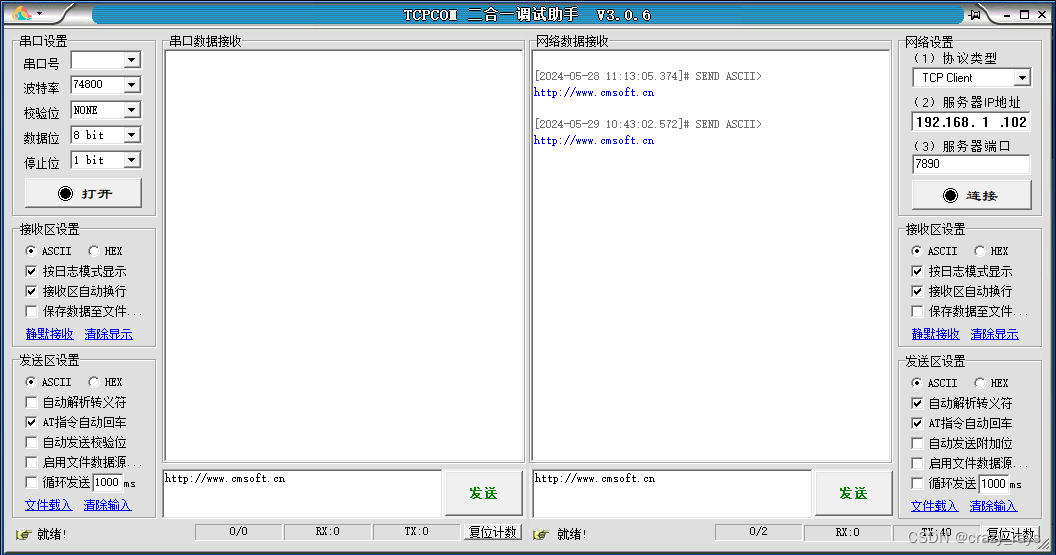Netty SSL双向验证
- 1. 环境说明
- 2. 生成证书
- 2.1. 创建根证书 密钥+证书
- 2.2. 生成请求证书密钥
- 2.3. 生成csr请求证书
- 2.4. ca证书对server.csr、client.csr签发生成x509证书
- 2.5. 请求证书PKCS#8编码
- 2.6. 输出文件
- 3. Java代码
- 3.1. Server端
- 3.2. Client端
- 3.3. 证书存放
- 4. 运行效果
- 4.1. SSL客户端发送消息:
- 4.2. 服务器收到SSL客户端消息:
- 4.3. 非SSL客户端发送消息:
- 4.4. 服务器收到非SSL客户端消息:
- 5. References:
1. 环境说明
- 本例使用windows10 + Win64OpenSSL-3_3_0(完整版,不是lite),netty版本4.1.77.Final,JDK-17
- openssl官方推荐合作下载地址:https://slproweb.com/download/Win64OpenSSL-3_3_0.exe
- ${openssl_home}是openssl的安装目录
- 所有命令在${openssl_home}/bin目录下执行
- windows下openssl的配置文件是${openssl_home}/bin/openssl.cfg,linux下是${openssl_home}/bin/openssl.conf,注意替换后缀名
- 需要手动按照openssl.cfg的配置创建好各种目录、文件
2. 生成证书
2.1. 创建根证书 密钥+证书
openssl genrsa -des3 -out demoCA/private/ca.key 4096openssl req -new -x509 -days 3650 -key demoCA/private/ca.key -out demoCA/certs/ca.crt
2.2. 生成请求证书密钥
openssl genrsa -des3 -out demoCA/private/server.key 2048openssl genrsa -des3 -out demoCA/private/client.key 2048
2.3. 生成csr请求证书
openssl req -new -key demoCA/private/server.key -out demoCA/certs/server.csr -config openssl.cfgopenssl req -new -key demoCA/private/client.key -out demoCA/certs/client.csr -config openssl.cfg
2.4. ca证书对server.csr、client.csr签发生成x509证书
openssl x509 -req -days 3650 -in demoCA/certs/server.csr -CA demoCA/certs/ca.crt -CAkey demoCA/private/ca.key -CAcreateserial -out demoCA/certs/server.crtopenssl x509 -req -days 3650 -in demoCA/certs/client.csr -CA demoCA/certs/ca.crt -CAkey demoCA/private/ca.key -CAcreateserial -out demoCA/certs/client.crt
2.5. 请求证书PKCS#8编码
openssl pkcs8 -topk8 -in demoCA/private/server.key -out demoCA/private/pkcs8_server.key -nocryptopenssl pkcs8 -topk8 -in demoCA/private/client.key -out demoCA/private/pkcs8_client.key -nocrypt
2.6. 输出文件
server端:ca.crt、server.crt、pkcs8_server.key
client端:ca.crt、client.crt、pkcs8_client.key
3. Java代码
3.1. Server端
- ServiceMain.java
public class ServiceMain implements CommandLineRunner {@Value("${netty.host}")private String host;@Value("${netty.port}")private int port;@Resourceprivate NettyServer nettyServer;public static void main(String[] args) {SpringApplication.run(ServiceMain.class, args);}@Overridepublic void run(String... args) throws Exception {InetSocketAddress address = new InetSocketAddress(host, port);ChannelFuture channelFuture = nettyServer.bind(address);Runtime.getRuntime().addShutdownHook(new Thread(() -> nettyServer.destroy()));channelFuture.channel().closeFuture().syncUninterruptibly();}
}
- NettyServer.java
package cn.a.service.netty;import io.netty.bootstrap.ServerBootstrap;
import io.netty.channel.Channel;
import io.netty.channel.ChannelFuture;
import io.netty.channel.ChannelOption;
import io.netty.channel.EventLoopGroup;
import io.netty.channel.nio.NioEventLoopGroup;
import io.netty.channel.socket.nio.NioServerSocketChannel;
import io.netty.handler.ssl.ClientAuth;
import io.netty.handler.ssl.SslContext;
import io.netty.handler.ssl.SslContextBuilder;
import lombok.extern.slf4j.Slf4j;
import org.springframework.context.ApplicationContext;
import org.springframework.stereotype.Component;
import org.springframework.util.ResourceUtils;import javax.annotation.Resource;
import java.io.File;
import java.net.InetSocketAddress;@Slf4j
@Component("nettyServer")
public class NettyServer {private final EventLoopGroup parentGroup = new NioEventLoopGroup();private final EventLoopGroup childGroup = new NioEventLoopGroup();private Channel channel;@ResourceApplicationContext applicationContext;/*** 绑定端口** @param address* @return*/public ChannelFuture bind(InetSocketAddress address) {ChannelFuture channelFuture = null;try {File certChainFile = ResourceUtils.getFile("classpath:server.crt");File keyFile = ResourceUtils.getFile("classpath:pkcs8_server.key");File rootFile = ResourceUtils.getFile("classpath:ca.crt");SslContext sslCtx = SslContextBuilder.forServer(certChainFile, keyFile).trustManager(rootFile).clientAuth(ClientAuth.REQUIRE).build();ServerBootstrap b = new ServerBootstrap();b.group(parentGroup, childGroup).channel(NioServerSocketChannel.class).option(ChannelOption.SO_BACKLOG, 1024).childHandler(new NettyChannelInitializer(applicationContext, sslCtx));channelFuture = b.bind(address).syncUninterruptibly();channel = channelFuture.channel();} catch (Exception e) {log.error(e.getMessage());} finally {if (null != channelFuture && channelFuture.isSuccess()) {log.info("netty server start done.");} else {log.error("netty server start error.");}}return channelFuture;}/*** 销毁*/public void destroy() {if (null == channel) return;channel.close();parentGroup.shutdownGracefully();childGroup.shutdownGracefully();}/*** 获取通道** @return*/public Channel getChannel() {return channel;}
}
- NettyChannelInitializer.java
package cn.a.service.netty;import io.netty.channel.ChannelInitializer;
import io.netty.channel.socket.SocketChannel;
import io.netty.handler.ssl.SslContext;
import org.springframework.context.ApplicationContext;public class NettyChannelInitializer extends ChannelInitializer<SocketChannel> {private final ApplicationContext applicationContext;private final SslContext sslContext;public NettyChannelInitializer(ApplicationContext applicationContext, SslContext sslCtx) {this.applicationContext = applicationContext;this.sslContext = sslCtx;}@Overrideprotected void initChannel(SocketChannel channel) throws Exception {// 添加SSL安装验证channel.pipeline().addLast(sslContext.newHandler(channel.alloc()));//发送时编码channel.pipeline().addLast(new FrameEncoder());//接收时解码channel.pipeline().addLast(new FrameDecoder());//业务处理器channel.pipeline().addLast(new NettyMsgHandler(applicationContext));}
}3.2. Client端
- TestClientApp.java
package cn.a.service;import cn.hutool.core.util.IdUtil;
import cn.hutool.core.util.NumberUtil;
import cn.a.service.netty.FrameDecoder;
import cn.a.service.netty.FrameEncoder;
import cn.a.service.netty.NettyMsg;
import cn.a.service.netty.Session;
import io.netty.bootstrap.Bootstrap;
import io.netty.channel.*;
import io.netty.channel.nio.NioEventLoopGroup;
import io.netty.channel.socket.SocketChannel;
import io.netty.channel.socket.nio.NioSocketChannel;
import io.netty.handler.ssl.SslContext;
import io.netty.handler.ssl.SslContextBuilder;
import lombok.extern.slf4j.Slf4j;
import org.springframework.boot.autoconfigure.SpringBootApplication;import java.io.File;
import java.util.Scanner;@Slf4j
@SpringBootApplication
public class TestClientApp {private static final Session session = new Session().setId(IdUtil.randomUUID());public static void main(String[] args) {new Thread(new TestThread("127.0.0.1", 7890)).start();}private static class TestThread implements Runnable {private final String serverHost;private final int serverPort;public TestThread(String serverHost, int serverPort) {this.serverHost = serverHost;this.serverPort = serverPort;}@Overridepublic void run() {EventLoopGroup group = new NioEventLoopGroup();try {final String certsDir = "D:\\GIT\\secim_service\\service\\src\\main\\resources\\";File certChainFile = new File(certsDir + "client.crt");File keyFile = new File(certsDir + "pkcs8_client.key");File rootFile = new File(certsDir + "ca.crt");SslContext sslCtx = SslContextBuilder.forClient().keyManager(certChainFile, keyFile).trustManager(rootFile).build();Bootstrap b = new Bootstrap();b.group(group).channel(NioSocketChannel.class).option(ChannelOption.TCP_NODELAY, true).handler(new ChannelInitializer<SocketChannel>() {protected void initChannel(SocketChannel ch) throws Exception {// 添加SSL安装验证ch.pipeline().addLast(sslCtx.newHandler(ch.alloc()));ch.pipeline().addLast(new FrameEncoder());ch.pipeline().addLast(new FrameDecoder());ch.pipeline().addLast(new TestClientHandler(session));}});// 发起异步连接操作ChannelFuture f = b.connect(serverHost, serverPort);f.addListener(future -> {startConsoleThread(f.channel(), session);}).sync();// 等待客户端连接关闭f.channel().closeFuture().sync();} catch (Exception e) {e.printStackTrace();} finally {// 优雅退出,释放NIO线程组group.shutdownGracefully();}}}/*** 开启控制台线程** @param channel*/private static void startConsoleThread(Channel channel, Session session) {new Thread(() -> {while (!Thread.interrupted()) {log.info("输入指令:");Scanner scanner = new Scanner(System.in);String input;while (!"exit".equals((input = scanner.nextLine()))) {log.info("输入的命令是:{}", input);if (!NumberUtil.isInteger(input)) {log.error("输入的指令有误,请重新输入");continue;}NettyMsg nettyMsg;switch (Integer.parseInt(input)) {case 1:nettyMsg = TestMsgBuilder.buildIdentityMsg(session);break;default:log.error("无法识别的指令:{},请重新输入指令", input);nettyMsg = null;break;}if (null != nettyMsg) {channel.writeAndFlush(nettyMsg);}}}}).start();}
}3.3. 证书存放

4. 运行效果
4.1. SSL客户端发送消息:

4.2. 服务器收到SSL客户端消息:

4.3. 非SSL客户端发送消息:

4.4. 服务器收到非SSL客户端消息:

5. References:
2020-07-14 15:01:55 小傅哥:netty案例,netty4.1中级拓展篇十三《Netty基于SSL实现信息传输过程中双向加密验证》
2017-07-04 11:44 骏马金龙:openssl ca(签署和自建CA)


)


)








连接到EMQX Platform【MQTT TLS/SSL 端口连接】)



)
